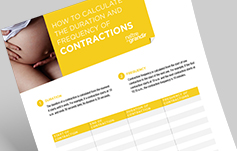Is it time to go to the hospital or birthing centre to deliver your baby? Before you hop in the car, it’s important to consider several factors.
As their due date approaches, many moms-to-be wonder how they’ll know when it’s time to go to their birth location. If this question is on your mind, check out the following tips.
When to go to the hospital or birthing centre
If your pregnancy is healthy and you’re at 37 weeks or more, it’s generally recommended that you call your doctor or midwife in the following situations to find out whether you should go to your birth location:
For a first pregnancy
Contractions that signal the start of true labour are painful and will increase in length and intensity. They can be felt in the lower abdomen or back.
-
You experience regular, painful 60second contractions every 5 minutes or less for 1 hour.
-
Your water breaks (loss of amniotic fluid). Loss of amniotic fluid should not be confused with the loss of your mucus plug. Losing your mucus plug doesn’t necessarily mean that you’re ready to give birth.
For a second or subsequent pregnancy
-
You experience regular contractions lasting at least 45 seconds every 5 minutes or less for 1 hour. If you live more than 30 minutes from your birth location, go as soon as you’re having contractions every 10 minutes.
Our downloadable guide will help you calculate the duration and frequency of your contractions.

-
Your water breaks (loss of amniotic fluid).
In general, labour progresses more quickly when you’ve given birth before. However, this may depend on how your previous delivery (or deliveries) went.
Talk to your doctor or midwife
Whether or not this is your first baby, you should discuss the birth with your doctor or midwife in the weeks leading up to your due date. They’ll be able to tell you when you should go to your birth location based on your previous delivery (or deliveries), the distance you need to travel, and your overall health.
Go to the hospital immediately in the following cases:-
Labour begins before 37 weeks of pregnancy
-
You experience vaginal bleeding (enough to soak a sanitary pad)
-
You notice that your baby’s movements are less frequent
-
Your belly remains hard and the contraction pain is constant
-
Labour begins but you’re scheduled for a caesarean section
|
If in doubt
Take a hot 30-minute bath. If the contractions begin to space out, you’re probably experiencing false labour. |
Many women go to their birth location too soon because they believe they’re in active labour when they’re actually still in early labour. In addition, it can be difficult to tell the difference between real and false contractions.
If you arrive at your birth location prematurely, you’ll be asked to return home, as the initial phase of labour can be quite long. You’ll be more comfortable at home and have an easier time getting used to the contractions. You can return to your birth location once labour is more advanced.
If you have any doubts or if you think labour has started, call your midwife or your hospital’s birthing unit. They’ll help you determine whether you’re in labour and when you should go to your birth location.
Things to keep in mind
-
Talk to your prenatal care provider about when you should go to your birth location.
-
Regular contractions may signal that it’s time to go to your birth location.
-
If you experience any warning signs (e.g., vaginal bleeding, less frequent baby movements), go to the hospital immediately.
| Scientific review: Amélie Guay, M.Sc., PNC(C), perinatal advanced practice clinical nurse, CHUM
Research and copywriting:The Naître et grandir team
Updated: September 2020
|
Photo: iStock/GOSPHOTODESIGN
Sources
Please note that hyperlinks to other websites are not updated regularly, and some may have changed since publication. It is therefore possible that a link may not be found. If a link is no longer valid, use search engines to find the relevant information.
-
Doré, Nicole, and Danielle Le Hénaff. From Tiny Tot to Toddler: A practical guide for parents from pregnancy to age two. Quebec City, Institut national de santé publique du Québec. www.inspq.qc.ca
-
Ladewig, Patricia, et al. Maternal & Child Nursing Care. 3rd ed., Upper Saddle River, Prentice Hall, 2011, 2,016 pp.
-
Perry, Shannon E., et al. Maternal Child Nursing Care. 6th ed., 2018, 1,568 pp.
-
Salus Global Corporation. “Prise en charge du travail.” MOREOB, 2019.
|